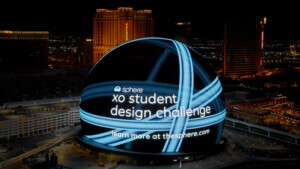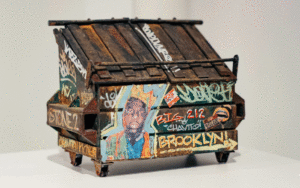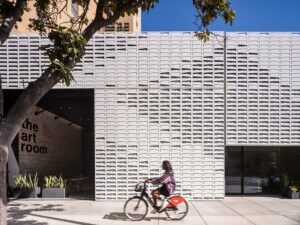| Brought to you with support from: | |
Designers in Indianapolis fabricate a graphic, splintered design.
Indiana-based design/build studio PROJECTiONE employs a multidisciplinary approach to its work that runs the gamut from digital to analog fabrication. Founders Adam Buente and Kyle Perry craftily bridged that gap with Synthetic Grain, a set piece for the Young & Laramore advertising agency of Indianapolis that explores the natural knotting and grain of lumber. The team used parametric software to create a graphic, 3D pattern system for an architectural screen that mimics natural variations of wood.
Working in Rhino, parallel lines—or the wood grain—were drawn and points were defined within. Each point served as a knot, around which the lines would gently curve. “Our only input for this project were those points in 3D space,” said Perry. To ready the design for fabrication, curves and cut holes for the plywood backing were generated in Grasshopper.
- Fabricators PROJECTiONE
- Designers PROJECTiONE
- Location Indianapolis
- Date of Completion February 2013
- Material polystyrene, plywood, wood stain, steel, screws
- Process Rhino, Grasshopper, laser cutting, friction fitting, screwing
Two hundred and eighty slats were laser cut from 4- by 8-foot sheets of polystyrene, including exacted “teeth” along the back of each fin that would slip into negative space scored into plywood backing. Because the screen was decorative, industrial plastics were a suitable project solution. “We needed something flexible so that the fins wouldn’t snap on us, and the pure white color really helped,” said Perry. Laser cutting also produced smooth edges that didn’t require any finishing.
Though most of the tolerances were worked out digitally, the designers tested tolerances of the laser cutter with several mockups, and also determined how much of a bend could be applied before the plastic snapped. In addition to physical testing, line angles were also explored within Grasshopper. Since each fin was bent to the plastic’s inherent tolerance, enough tension was created to friction joint each fin into the wood. Eight plywood backing panels were also laser cut with varying curved edges to best optimize the curved patterns of the adjacent fins. A steel frame was fabricated to support the freestanding, 12-foot-long installation that reached 3-1/2 feet in height at a depth of 4 inches.
The application for this installation of Synthetic Grain was predetermined, but Perry and Buente were not shortsighted in their plans for the future of the design. “We thought we’d make the Grasshopper definition variable,” explained Perry. “We tried to make it flexible enough to adjust ‘this’ and output ‘that’ quickly, so it could be scaled for a building typology.” At a grander scale, a building screen or parking garage facade could be fashioned from metals or thicker plastics. Retail storefronts could benefit from the visual transparency of the faux bois rhythms, or hospitality projects could adopt it as an alternative to a porous surface.










